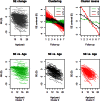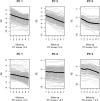Patterns in longitudinal growth of refraction in Southern Chinese children: cluster and principal component analysis
- PMID: 27874105
- PMCID: PMC5118713
- DOI: 10.1038/srep37636
Patterns in longitudinal growth of refraction in Southern Chinese children: cluster and principal component analysis
Abstract
In the present study we attempt to use hypothesis-independent analysis in investigating the patterns in refraction growth in Chinese children, and to explore the possible risk factors affecting the different components of progression, as defined by Principal Component Analysis (PCA). A total of 637 first-born twins in Guangzhou Twin Eye Study with 6-year annual visits (baseline age 7-15 years) were available in the analysis. Cluster 1 to 3 were classified after a partitioning clustering, representing stable, slow and fast progressing groups of refraction respectively. Baseline age and refraction, paternal refraction, maternal refraction and proportion of two myopic parents showed significant differences across the three groups. Three major components of progression were extracted using PCA: "Average refraction", "Acceleration" and the combination of "Myopia stabilization" and "Late onset of refraction progress". In regression models, younger children with more severe myopia were associated with larger "Acceleration". The risk factors of "Acceleration" included change of height and weight, near work, and parental myopia, while female gender, change of height and weight were associated with "Stabilization", and increased outdoor time was related to "Late onset of refraction progress". We therefore concluded that genetic and environmental risk factors have different impacts on patterns of refraction progression.
Conflict of interest statement
The authors declare no competing financial interests.
Figures



Similar articles
-
Annual changes in refractive errors and ocular components before and after the onset of myopia in Chinese children.Ophthalmology. 2012 Jul;119(7):1478-84. doi: 10.1016/j.ophtha.2012.01.017. Epub 2012 May 10. Ophthalmology. 2012. PMID: 22578257
-
Contribution of Genome-Wide Significant Single Nucleotide Polymorphisms in Myopia Prediction: Findings from a 10-year Cohort of Chinese Twin Children.Ophthalmology. 2019 Dec;126(12):1607-1614. doi: 10.1016/j.ophtha.2019.06.026. Epub 2019 Jul 2. Ophthalmology. 2019. PMID: 31416661
-
Comparison of myopic progression in Finnish and Singaporean children.Acta Ophthalmol. 2021 Mar;99(2):171-180. doi: 10.1111/aos.14545. Epub 2020 Jul 24. Acta Ophthalmol. 2021. PMID: 32706181 Clinical Trial.
-
Incidence of and Factors Associated With Myopia and High Myopia in Chinese Children, Based on Refraction Without Cycloplegia.JAMA Ophthalmol. 2018 Sep 1;136(9):1017-1024. doi: 10.1001/jamaophthalmol.2018.2658. JAMA Ophthalmol. 2018. PMID: 29978185 Free PMC article.
-
Risk factors for high myopia: a 22-year follow-up study from childhood to adulthood.Acta Ophthalmol. 2019 Aug;97(5):510-518. doi: 10.1111/aos.13964. Epub 2018 Nov 20. Acta Ophthalmol. 2019. PMID: 30460746 Clinical Trial.
Cited by
-
The Role of Time Exposed to Outdoor Light for Myopia Prevalence and Progression: A Literature Review.Clin Ophthalmol. 2020 Jul 2;14:1875-1890. doi: 10.2147/OPTH.S245192. eCollection 2020. Clin Ophthalmol. 2020. PMID: 32669834 Free PMC article. Review.
-
Axial Elongation Trajectories in Chinese Children and Adults With High Myopia.JAMA Ophthalmol. 2024 Feb 1;142(2):87-94. doi: 10.1001/jamaophthalmol.2023.5835. JAMA Ophthalmol. 2024. PMID: 38153745 Free PMC article.
-
Prevalence and Possible Factors of Myopia in Norwegian Adolescents.Sci Rep. 2018 Sep 7;8(1):13479. doi: 10.1038/s41598-018-31790-y. Sci Rep. 2018. PMID: 30194363 Free PMC article. Clinical Trial.
-
Cohort study with 4-year follow-up of myopia and refractive parameters in primary schoolchildren in Baoshan District, Shanghai.Clin Exp Ophthalmol. 2018 Nov;46(8):861-872. doi: 10.1111/ceo.13195. Epub 2018 Apr 16. Clin Exp Ophthalmol. 2018. PMID: 29577563 Free PMC article.
-
Refractive Error in Chinese Preschool Children: The Shanghai Study.Eye Contact Lens. 2019 May;45(3):182-187. doi: 10.1097/ICL.0000000000000555. Eye Contact Lens. 2019. PMID: 30260815 Free PMC article.
References
-
- Saw S. M., Gazzard G., Shih-Yen E. C. & Chua W. H. Myopia and associated pathological complications. Ophthalmic Physiol Opt 25, 381–91 (2005). - PubMed
-
- Morgan I. G., Ohno-Matsui K. & Saw S.-M. Myopia. The Lancet 379, 1739–1748 (2012). - PubMed
-
- Saw S. M. et al.. Factors related to the progression of myopia in Singaporean children. Optom Vis Sci 77, 549–54 (2000). - PubMed
-
- Baird P. N., Schäche M. & Dirani M. The GEnes in Myopia (GEM) study in understanding the aetiology of refractive errors. Progress in Retinal and Eye Research 29, 520–542 (2010). - PubMed
Publication types
MeSH terms
LinkOut - more resources
Full Text Sources
Other Literature Sources

